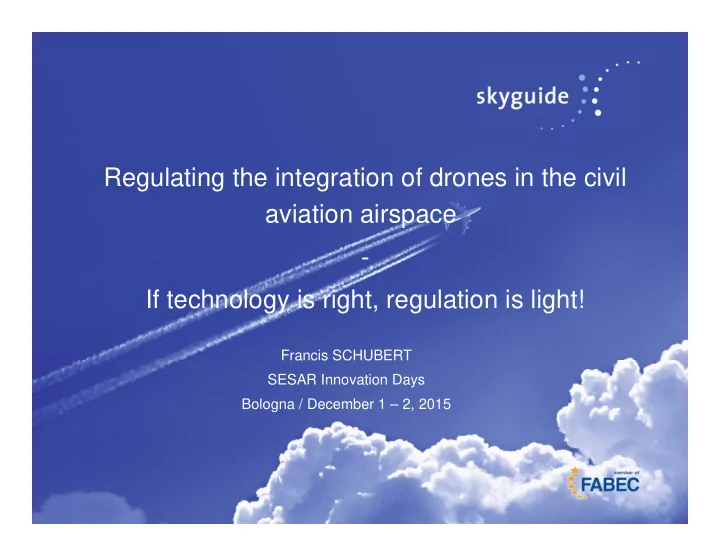

›Regulating the integration of drones in the civil aviation airspace ›- ›If technology is right, regulation is light! ›Francis SCHUBERT ›SESAR Innovation Days ›Bologna / December 1 – 2, 2015 1
2
Introduction › Massive expansion of the UAV (Drones) sector Numbers Types Applications › Regulatory challenge / opportunity Technology ahead of regulation and gap widening Need to understand the extent and nature of the drones impact on the air transportation system Need for a pragmatic, light and performance based regulatory framework 3
Regulatory Framework – ICAO › Article 8 of the Convention on International Civil Aviation (Chicago Convention) › Manual on Remotely Piloted Aircraft Systems (RPAS), ICAO Doc 10019, AN/507, 1st Edition 2015. › Focused on RPAS › Air navigation system, after RPAS integration, must be as safe or safer than existing system › Same rules for commercial / non-commercial applications › No weight limit 4
Regulatory Framework – EASA › Introduction of a regulatory framework for the operation of drones, EASA Advance Notice of Proposed Amendment 2015-10, 31 July 2015. › Covers all UAVs (drones) › Risk based (safety, security and personal data protection) › Three segments Open Specific Certified 5
EASA Regulatory Framework EU Aviation Outside of EU Aviation regulatory framework regulatory framework OPEN SPECIFIC CERTIFIED • Regulatory regime • NAA Authorisation • No involvement of similar to manned • Specific Aviation Authority aviation • LIMITATIONS: qualification of • EASA and Visual line of sight, drone, personnel, Authority max altitude, equipment, based Certificates on safety distance from assessment airport and sensitive zones 6
Integration strategies: From segregation to autonomous separation Segregation Pilot mitigation (VLOS etc) BLOS ATC separation and traffic info Autonomous separation 7
Certified Segment › High risk / High interference with civil aviation authorities › Condition for integration: Ability of drones to behave like «ordinary» aircraft Detect and avoid capability › Integration strategy: ATC separation and traffic information Autonomous separation › «Drone» status largely irrelevant from an ATC perspective Drone specific procedures by exception only and focused on particularities that cannot be mitigated otherwise: Specific operations (extreme endurance, pattern flight, C2 link failure, airspace infringement, etc.) 8
Specific Segment › Medium risk / Limited interference with civil aviation activities E.g. crossing of airway / approach path, targeted operation in civil airspace › Assumes inability of drone to behave like an ordinary aircraft or to comply with rules of the air (e.g. statutory separation, see/detect and avoid, etc.) › Risk to be mitigated by: Safety case including mitigation measures detailed in an operations manual, approved by competent authority 9
Open segment › Low risk / Low interference with civil aviation activities Drones operating: Below airspace open to civil aviation Away from airports › Mitigation strategies Pilot control measures (VLOS) Autonomous flight measures 10
Open segment › Need for a traffic management infrastructure in the open segment Resist temptation to import practices from legacy ATM Numbers speak for automation Geofencing Open segment offers opportunity to develop and validate innovative solutions that are impracticable to test in the certified segment, and to export them later into the airspace open to civil aviation (laboratory value) UTM: UAV Traffic Management 11
12
Conclusions › The «dual drones world» The overwhelming majority of drones will operate in the open segment, and will not interfere with civil aviation activities (by regulation and by technical design) A minority of drones will operate in the certified segment. These will have the ability to behave as «ordinary aircraft» to the farthest extent possible › Technology as a substitute for hard regulation › The «laboratory» potential of the open segment 13
Recommend
More recommend